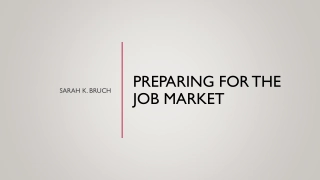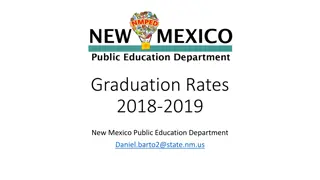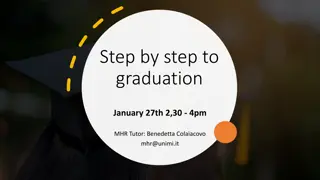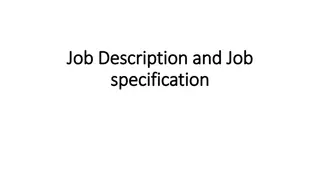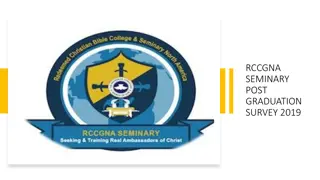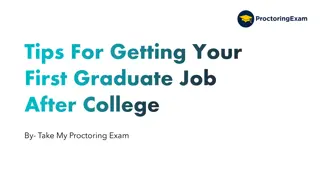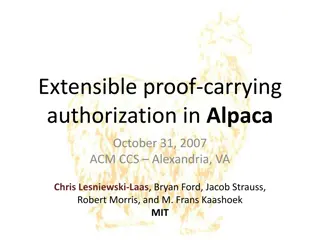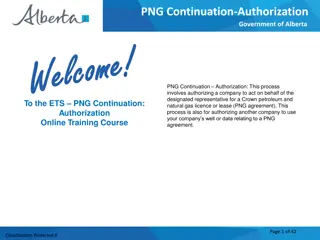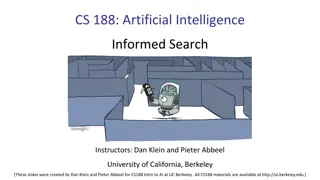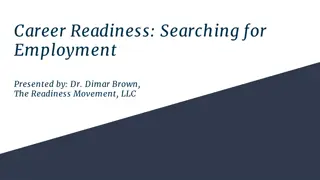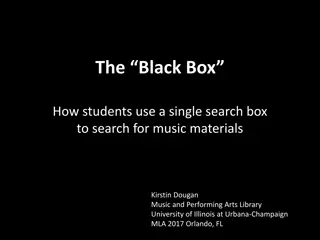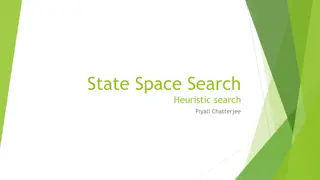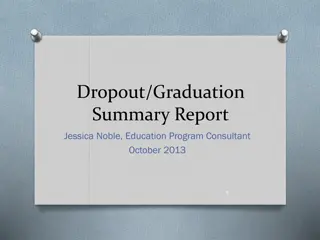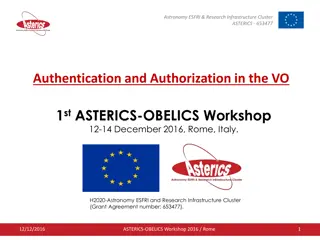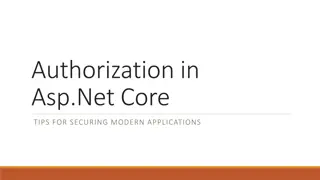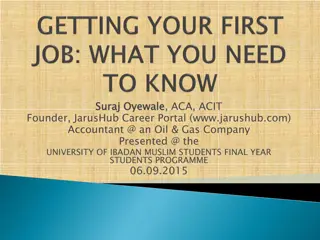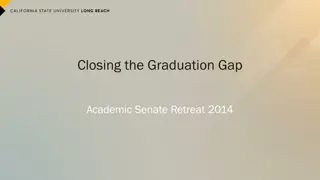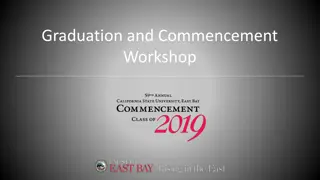Navigating Post-Graduation: Job Search and Work Authorization Tips
After graduation, start looking for a job in your final semester to secure work authorization smoothly. Answer questions about work authorization honestly and plan for future sponsorship if needed. Be proactive and understand the process to ensure a successful transition to the workforce.
Download Presentation

Please find below an Image/Link to download the presentation.
The content on the website is provided AS IS for your information and personal use only. It may not be sold, licensed, or shared on other websites without obtaining consent from the author.If you encounter any issues during the download, it is possible that the publisher has removed the file from their server.
You are allowed to download the files provided on this website for personal or commercial use, subject to the condition that they are used lawfully. All files are the property of their respective owners.
The content on the website is provided AS IS for your information and personal use only. It may not be sold, licensed, or shared on other websites without obtaining consent from the author.
E N D
Presentation Transcript
Im Graduating! Now, what? (INTERNATIONAL SERVICES SEMINAR SPRING 2023)
International Services (ISO) Introduction Remy Allen- Director (rall11@lsuhsc.edu) John Lorch- Administrator (jlorc1@lsuhsc.edu) Open-door policy, but appointment highly preferred When scheduling an appointment, provide brief description of what you need from ISO (some things could be resolved via e-mail) Always send ISO-related e-mails to both Remy & John, unless student considers e-mail to be extremely sensitive
When should I Start looking for a job and applying for positions? In your final semester. At that point, you have a more predictable timeline to explain to employers. The sooner you have a concrete job offer, the easier it will be to determine what dates you want to request for your OPT period, if you haven t applied yet. There is some flexibility (about 60 days) as to when your OPT period begins/ends. You are only permitted 90 days of unemployment once your OPT period has begun. Finding and beginning a job always takes longer than you think it will Applying as early as possible allows the maximum amount of time to find employment. (90 days from graduation + 60 day grace period = 150 days) Apply for post-completion OPT (work authorization)? Applications can be sent in 90 days before I-20 end date. ISO will send a reminder about 4 months in advance.
How do I answer Questions about work authorization? Employers CAN ask if you have full time U.S. work authorization Often asked as part of application process/pre-interview screening If applying prior to receiving your OPT EAD card, the answer is no. If you answer no, a common follow up question is: Do you currently require sponsorship for full time U.S. work authorization? If you have applied for OPT (which we expect to be approved), the answer is no. You may not have an opportunity to explain that you are expecting to receive OPT authorization during a written application process, but you can do this later.
How do I answer(contd) If you answer that you do not need current sponsorship, another common follow up question is: Will you require sponsorship for full time U.S. work authorization in the future? You should answer yes to this. After your initial OPT (and STEM OPT) period have ended, you will no longer be able to provide your own work authorization through F-1 status. Most likely, your employer will need to begin sponsoring your work authorization to allow you to continue working after OPT/STEM OPT. (J-1, H-1B, TN, etc.)
How do I answer (contd) Questions about my status? It is not advisable for employers to ask questions about immigration/citizenship status during the application/interview process, but some will U.S. federal anti-discrimination laws will prevent many employers from asking applicants about their immigration status or national origin. See more from EEOC here: Federal Laws Prohibiting Job Discrimination Questions And Answers | U.S. Equal Employment Opportunity Commission (eeoc.gov) Some employers are not aware that it is not advisable to ask this due to lack of training, etc.
How do I answer (contd) Some employers ask these questions to get information they need for other reasons. Some employers do not provide any immigration sponsorship for employees, as a matter of policy. There are many reasons for this. It can be expensive and time consuming. Some companies do not want the obligations that come with providing work authorization sponsorship and/or cannot afford the cost and time required. Some positions require that the person be a U.S. Citizen or Permanent Resident due to federal regulations and restrictions. (example: SEVP Designated School Officials) Some items, data and technology are controlled, and access is only permitted for U.S. Citizens or Permanent Residents unless an export control license is obtained by the employer (not an easy process). Some state/local laws require employers to obtain certain information about an applicant s citizenship status, foreign affiliations, education and training, before offering them a job.
How do I answer(contd) What are some options to address issues around work authorization and immigration status when applying for jobs? Don t mention it unless directly asked. If asked, always be truthful about your situation. I am currently in F-1 student status, and have applied/will apply for one year of work authorization requested to begin on [date]. I expect to receive my EAD card/submit my application in approximately [x] months. If STEM eligible (see here: OPT STEM Extensions (lsuhsc.edu)), can add My work authorization can be extended for an additional 2 years, if my employer participates in E-verify. This is a great time ask if the employer participates in E-verify. That answer might help determine if this employer is the best one for you. If you can t use your STEM extension there, perhaps another employer (where you can) is a better option. Are you an E-verify employer? Put the information about your work authorization/status on your CV. F-1 status, OPT application pending/Will apply for post-completion OPT This could keep you from getting an interview if the employer is not willing to provide work authorization sponsorship. It can also help by showing you are aware of your own circumstances, and are wiling to be transparent about that. It keeps everyone from wasting time if the situation is not workable on either side.
How do I answer(contd) Work this information into the interview conversation. But, how ? Most employers will have a start date in mind, or ask about when you would be available to start. That is a great opportunity to explain your situation I am currently in F-1 student status, and have applied/will apply for one year of work authorization requested to begin on [date]. I expect to receive my EAD card/submit my application in approximately [x] months. I should be available to start on [date]. Many employers will ask about how long you envision being in the position/with their company. That is another opportunity to explain your situation My current status can provide one/three years of work authorization following degree completion. To remain employed in the U.S./at your company after that, I anticipate I would require employer work authorization sponsorship.
I got an offer! Is it a good one? Just ANY employment won t work The F-1 regulations require that employment while on OPT or STEM OPT be directly related to your major area of study and commensurate with your degree level. Does this mean if my degree is in Biostatistics that my title must be Biostatistician? NO. The title/department that houses the position does NOT have to match the degree. Could my basic science PhD be directly related to a clinical position? Certainly the basic research side that develops treatment and the clinical patient care side that delivers it are not unrelated. There are plenty of MD/PhD programs they are considered very related can be integrated. If it is not clear from the job title that the work is related to your degree, we recommend that you get a signed letter from your hiring official, supervisor, or manager explaining how your degree is related to the work performed. Will this issue ever come up? It is fairly unlikely, but good to be prepared to defend your employment as appropriate in writing. Please note that during the initial OPT period (12 months), you are NOT required to be paid. During STEM OPT (24 months) you ARE required to be a paid employee.
I got an offer! Is it a good one? How do I figure out if the pay offered is fair? Some states (14) and cities (5) require a salary range to be listed in any advertisement. If a range is listed, you can see where your offer is within that range. If you are a new graduate and meet only the minimum requirements, your offer will likely be closer to the lower end of the range. However, if you are overqualified for the position (it requires a bachelor s degree, and you have a master s), then your offer should be closer to the middle or top of the range. What if they don t provide a salary range? Some good guidance for postdocs is the NIH scale. The U.S. Department of Labor breaks down wage information by geographic area and occupation in the FLC Data Center (shows both annual and hourly rates). There are different wages for Higher Education institutions vs. all industries. Pay attention to which set you are viewing! Sometimes it is not obvious how to fit the job title into one of the listed occupations. Example: Postdoctoral Researcher is not listed, 19-1042 Medical Scientists, Except Epidemiologists is the code we use at LSUSHC.
I got an offer! Can I live on that? How do I figure out if I can support myself with the pay offered? Keep in mind that the pay offered in your letter or contract is NOT the amount you will end up receiving in your paycheck. That offer is pre-tax, and does not include deductions for benefits you may choose, like health insurance and retirement. smartasset.com can help in calculating your actual take home pay here. This only accounts for tax deductions, so keep that in mind. Living costs vary by location Salary.com has a great tool for this! Cost of Living Calculator | Salary.com Is fully remote or hybrid work permitted? Can you live outside of a major metro area and work remotely, at least some days? If you are only required to commute to a specific location two days per week, that may help save on costs. Remote work is permitted while on OPT/STEM OPT. We ll make a note of any remote work in your SEVIS record, so make sure you report it.
I accepted the job! All this paperwork Employers will send what feels like a mountain of paperwork (electronic) that must be completed before you may begin working. It can be overwhelming Tax paperwork Employers will ask you to complete a W-4 (federal tax withholding) and a state tax withholding form. There is some information on this available here. If you are a graduating F-1, and starting your initial OPT period, you are likely still a non-resident for tax purposes. You can find some information on how to figure that out and examples here. Your employer most likely will NOT have someone who can help with this determination or can assist in completing the required forms. Companies like Sprintax can also assist with these forms, but will charge a fee. (Starts at $20, it s probably worth it!) They also assist with tax returns. Fees start at around $50! We have a link for this on our website page about U.S. Tax Basics.
I accepted the job! All this paperwork (cont d) I-9 completion This form is required for ALL employees. The official I-9 Central website tells you how to complete the employee part of the form (Section 1, Page 1). If you are in F-1 status during OPT, you are An alien authorized to work (Box 4) and the expiration date for your work authorization is the end date on the FRONT of your EAD card. An I-766 EAD card received after approval of an OPT application is an acceptable List A document on its own (it shows both your identity and work authorization information). No other documentation is needed for I-9 completion. The original document should be presented in person for I-9 completion. Your employer may make a copy of the document to keep with your I-9. The original should be returned to you. It should NOT be kept by the employer.
My OPT/STEM OPT is running out! What options do I have? The most commonly used status for work authorization following the expiration of F-1 OPT or STEM OPT status is an employer sponsored H1B. There are other potential employer sponsored options available, such as J-1 and possibly TN, if you and the position qualify. J-1 status sometimes has certain restrictions on future immigration benefits, which may not make it the most preferable option. See more on that here: 212(e) (lsuhsc.edu) H1B criteria: The position must be paid employment and require at least a bachelor s degree in a specialized field of study. Just because you (the potential beneficiary) have a Master s degree or PhD does not mean this is a requirement for the position. Your credentials may exceed the position s requirements. The H1B beneficiary must be eligible for H1B status based on their immigration history. H1B status is limited to a total duration of six calendar years. Additional time may be available if in the Permanent Residency process.
My OPT/STEM OPT is running out! What should I do and when? It depends on what type of employer you have. If your employer is in private industry, and is a for-profit enterprise (a capped employer), your employer must submit an H1B petition for you on a specific timeline (typically around April 1stof each year) to ensure your application can be accepted by USCIS. Electronic registration for the H1B lottery usually starts on or around March 1st. The start date for the H1B MUST be October 1st. You may be eligible for cap gap to allow you to continue working until October 1st, even if your OPT/STEM OPT period ends before that date. More here: Cap Gap Extensions (lsuhsc.edu) If your employer is considered a cap-exempt entity (like most Universities, public hospitals, state and city governments, charitable entities), they can file an H1B for you at any time during the year. The petition can be submitted UP TO six months in advance of the start date. For example, if your OPT ends on May 15th, your H1B petition would need to request a start date of May 16thto avoid any gaps in work authorization. That means the petition can be submitted to USCIS no earlier than November 16thof the previous year.
My OPT/STEM OPT is running out! What should I do and when? (cont d) Start discussing your post-OPT/STEM OPT options with your employer EARLY. For capped employers, we typically recommend starting to discuss transition to H1B status NO LATER than January of the year you would need them to file the H1B for you. They have to file by April 1stor so, so that leaves only a 3 month window. You can (and in most cases should) start this discussion earlier. If they are not able or willing to submit an H1B for you, you will need time to make decisions about what to do. Locate another employer? Leave the U.S.? If you have a STEM OPT extension available and are at a capped employer, it may be advisable to attempt to convert to H1B status during your regular OPT period. That way, if your case is not accepted by USCIS in that year, you will have additional chances to apply during your STEM OPT period. The down side that your six years of H1B time will start running immediately, if you are approved. Yes, you can apply for BOTH a STEM OPT extension and an H1B. But, you will only have ONE status. It will be either F-1 or H1B. For cap-exempt employers, we recommend discussing the transition to H1B status about 8 months before your OPT/STEM OPT period expires. This timeline should allow your H1B petition to be filed as close to the six month mark as possible, and may save your employer additional expedited processing fees than if the petition is filed later. All H1B petitions that request a Change of Status within the U.S. must be APPROVED before work under H1B status may begin/continue. If your OPT/STEM OPT has expired, and your H1B petition is still pending, you CANNOT continue working until the H1B petition is approved.
Submitted Questions Work allowances for F-1 students F-1 students are limited to 20 hours per week of on campus employment under the F-1 regulations (Graduate Assistant, student worker, etc.) F-1 students may receive part time CPT authorization (up to 20 hours per week) in addition to their on campus employment if they are completing degree requirements and receiving course credit through a paid internship or employment that is part time. Must receive a CPT authorized I-20. F-1 students may receive authorization for full time CPT (up to 40 hours per week) if completing degree requirements and receiving course credit through a paid internship or employment that is full time. Students with full time CPT authorization may NOT also engage in on campus employment.


